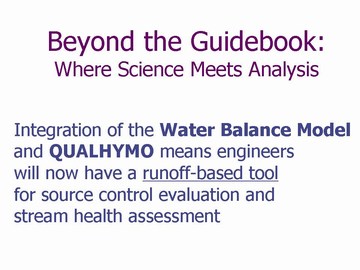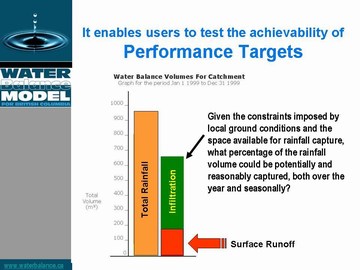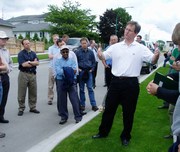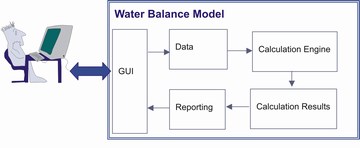'Beyond the Guidebook' Explained: from Stormwater Management to Rainwater Management

The drainage vocabulary in British Columbia is in transition, and is being simplified so that there will be a clearer public understanding of source control options for capturing rain where it falls. Furthermore, drainage practitioners are advancing the design of green infrastructure so that cumulative benefits rather than cumulative impacts can accrue over time.
“Beyond the Guidebook” refers to a runoff-based approach to drainage modeling that connects the dots between source control evaluation and stream health assessment. In a nutshell, it means this is ‘where science meets analysis’ because runoff volume management is directly linked to stream erosion and water quality.
The First Paradigm-Shift
“When Stormwater Planning: A Guidebook for British Columbia was published in 2002, it set in motion a chain of outcomes that has resulted in British Columbia being recognized internationally as a leader in implementing a natural systems approach to rainwater management in the urban environment”, states Peter Law (BC Ministry of Environment), Chair of the Guidebook Steering Committee, “The Guidebook established the framework for rainfall capture and a performance target way-of-thinking and designing.”
One of the Guidebook outcomes was the Water Balance Model for British Columbia, an online decision support and scenario modeling tool. It helps practitioners wrap their minds around how to achieve a light ‘hydrologic footprint’ and implement ’green solutions’. The focus is on source controls for reduction of rainwater runoff volume.

The Next Paradigm-Shift
According to Laura Maclean (Environment Canada), Co-Chair of the Inter- Governmental Partnership that developed the Water Balance Model, “Beyond the Guidebook takes the Guidebook innovation to the next level of evolution, Now that practitioners are becoming comfortable with what ‘rainfall capture’ means in practice, local governments and the development community are in a position to turn their attention to what is an achievable outcome that makes sense and results in a net environmental benefit at the watershed scale.”
Governmental Partnership that developed the Water Balance Model, “Beyond the Guidebook takes the Guidebook innovation to the next level of evolution, Now that practitioners are becoming comfortable with what ‘rainfall capture’ means in practice, local governments and the development community are in a position to turn their attention to what is an achievable outcome that makes sense and results in a net environmental benefit at the watershed scale.”
 “The pilot for Beyond the Guidebook is the Fergus Creek watershed plan that the City of Surrey recently completed”, adds David Hislop (City of Surrey), a member of the Inter-Governmental Partnership steering committee, “The plan is based entirely on implementing ‘green solutions’ as an alternative to conventional engineered ‘blue solutions’. There will be no storage ponds. Rather, rainwater runoff volume will be managed through the creation of contiguous large-scale greenways.”
“The pilot for Beyond the Guidebook is the Fergus Creek watershed plan that the City of Surrey recently completed”, adds David Hislop (City of Surrey), a member of the Inter-Governmental Partnership steering committee, “The plan is based entirely on implementing ‘green solutions’ as an alternative to conventional engineered ‘blue solutions’. There will be no storage ponds. Rather, rainwater runoff volume will be managed through the creation of contiguous large-scale greenways.”
To Learn More:
For an overview of the Beyond the Guidebook philosophy and a detailed explanation of the methodology for connecting the dots between source controls and stream health, click on Inter-Governmental Partnership Rolls Out ‘Beyond the Guidebook’ at Water Balance Model Forum.
This is a the comprehensive story on the rollout at the Water Balance Model Partners Forum in March 2007.
Runoff-Based Tool
Integration of the Water Balance Model with QUALHYMO will enable hydrological engineers to go Beyond the Guidebook in achieving stream health protection and water quality objectives. The Water Balance Model powered by QUALHYMO will enable assessment of source control performance plus model the overflows once source controls have reached capacity.

Change the Language, Change the Outcome
Changing the vocabulary of drainage practitioners is part and parcel of implementing ‘integrated solutions’ that are landscape-based, and are guided by this over-arching principle:
- The way land is developed determines how water is used, and how water runs off the land.
According to Kim Stephens, Program Coordinator for the Water Sustainability Action Plan for British Columbia, “The single function view of traditional stormwater management is giving way to the integrated and comprehensive perspective that is captured by the term rainwater management. Stormwater suggests there is a  problem, whereas rainwater is a resource. Continued use of the term ‘stormwater managemen’ can be viewed as perpetuating a 1970s and 1980s way-of-thinking where the focus is narrow and is concerned with a handful of storm events. Contemporary rainwater management, on the other hand, accounts for all the rainfall-days that occur each year. Furthermore, use of the term rainwater management resonates with the average citizen in a way that stormwater management never can.”
problem, whereas rainwater is a resource. Continued use of the term ‘stormwater managemen’ can be viewed as perpetuating a 1970s and 1980s way-of-thinking where the focus is narrow and is concerned with a handful of storm events. Contemporary rainwater management, on the other hand, accounts for all the rainfall-days that occur each year. Furthermore, use of the term rainwater management resonates with the average citizen in a way that stormwater management never can.”
 Rainwater management encompasses both water use and rainwater runoff because the common link is soil depth. Desired rainwater management outcomes include using less irrigation water and reducing rainwater runoff. In this regard, the award-winning East Fraserlands project in Vancouver is also a Beyond the Guidebook case study. The rainwater management plan demonstrates how to apply performance target objectives and the Water Balance Model in a high density development that will be built along the Fraser River.
Rainwater management encompasses both water use and rainwater runoff because the common link is soil depth. Desired rainwater management outcomes include using less irrigation water and reducing rainwater runoff. In this regard, the award-winning East Fraserlands project in Vancouver is also a Beyond the Guidebook case study. The rainwater management plan demonstrates how to apply performance target objectives and the Water Balance Model in a high density development that will be built along the Fraser River.
The City of Vancouver has won the 2007 Canadian Institute of Planners Award for Planning Excellence in the neighbourhood-planning category for the East Fraserlands Official Development Plan. This is the development blueprint for the next 25 years. “The East Fraserlands project may well be the most rigorous and sophisticated application of the Water Balance Model undertaken to date”, notes Kim Stephens.


